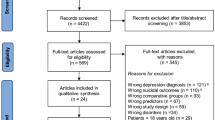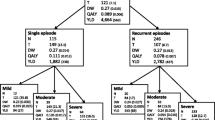Abstract
Background
Age of onset of major depression seems to be dropping in Western nations. Early onset usually predicts a more serious illness with a relatively poor prognosis. Since depression is associated with suicide, this begs the question of whether early onset of depression is associated with the degree of intent of suicidal behaviour, and whether this relationship differs according to gender.
Methods
Relevant responses from 9,282 residents of the United States were drawn from a nationally representative community survey conducted in 2001 through 2003 using the W.H.O. version of the Composite International Diagnostic Interview. The primary outcome measure was the retrospectively determined age of first major depressive episode.
Results
Younger age of onset for depression was associated with higher levels of suicidal intent, irrespective of age at the time of interview. A significant interaction between level of intent and age at interview appeared to be accounted for by the later onset among those in the eldest cohort who reported an absence of suicidal behaviour. The influence of suicidal intent on onset of depression was greater for women than for men.
Conclusions
The earlier the age of first symptoms of major depressive episode, the higher the degree of suicidal intent, irrespective of age at interview and gender, although the more pronounced trend for women suggests a greater sensitivity to underlying factors that may involve depression and lead to suicide risk.


Similar content being viewed by others
References
Angold A, Costello EJ, Erkanli A, Worthman CM (1999) Pubertal changes in hormone levels and depression in girls. Psychol Med 29:1043–1053
Angold A, Costello EJ, Worthman CM (1998) Puberty and depression: the roles of age, pubertal status and pubertal timing. Psychol Med 28:51–61
Beck AT, Kovacs M, Weissman A (1979) Assessment of suicidal intention: the scale for suicidal ideation. J Consult Clin Psychol 47:343–352
Bland RC, Newman SC, Orn H (1986) Recurrent and non-recurrent depression: a family study. Arch Gen Psychiatry 43:1085–1089
Bland RC, Orn H, Newman SC (1988) Lifetime prevalence of psychiatric disorders in Edmonton. Acta Psychiatr Scand 77(Suppl 338):24–32
Cohen P, Cohen J, Kasen S, Valez CN, Hartmark C, Johnson J, Rojas M, Brook J, Streuning EL (1993) An epidemiological study of disorders in late childhood and adolescence, 1: age- and gender-specific prevalence. J Child Psychol Psychiatry 34:851–867
Cross-National Collaborative Group (1992) The changing rate of major depression. JAMA 268:3098–3105
Cyranowski JM, Frank E, Young E, Shear MK (2000) Adolescent onset of the gender difference in lifetime rates of major depression: a theoretical model. Arch Gen Psychiatry 57:21–27
Farberow NL (1989) Preparatory and prior suicidal behaviour factors. In: Davidson L, Linnoila M (eds) Alcohol, drug abuse and mental health administration: report of the secretary’s task force for youth suicide, vol 2. U.S. Government Printing Office, Washington
Harris EC, Barraclough B (1998) Excess mortality of mental disorder. Br J Psychiatry 173:11–53
Hautzinger M (1984) Age distribution of depressive episodes in a community sample. Psychiatr Prax 11:196–199
Kandel DB, Davies M (1986) Adult sequelae of adolescent depressive symptoms. Arch Gen Psychiatry 43:255–262
Kessel N (1966) The respectability of self-poisoning and the fashion of survival. J Psychosom Res 10:29–36
Kessler RC (2006) National comorbidity survey: replication (NCS-R), 2001–2003 [Computer file]. Conducted by Harvard Medical School, Department of Health Care Policy/University of Michigan, Survey Research Center. ICPSR04438-v1. Ann Arbor, MI: Inter-university Consortium for Political and Social Research [producer and distributor], 2006-06-07. http://www.hcp.med.harvard.edu/ncs/. Verified on October 13, 2006
Kessler RC, Berglund P, Chiu WT, Demler O, Heeringa S, Hiripi E, Jin R, Pennell BE, Walters EE, Zaslavsky A, Zheng H (2004) The US National Comorbidity Survey Replication (NCS-R): design and field procedures. Int J Methods Psychiatr Res 13(2):69–92
Kessler RC, Borges G, Walters EE (1999) Prevalence of and risk factors for lifetime suicide attempts in the National Comorbidity Survey. Arch Gen Psychiatry 56:617–626
Kessler RC, McGonagle KA, Swartz M, Blazer DG, Nelson CB (1993) Sex and depression in the national comorbidity survey, II: cohort effects. J Aff Dis 30:15–26
Kessler RC, Merikangas KR (2004) The national comorbidity survey replication (NCS-R): background and aims. Int J Methods Psychiatr Res 13(2):60–68
Kessler RC, Ustun TB (2004) The world mental health (WMH) survey initiative version of the world health organization (WHO) composite international diagnostic interview (CIDI). Int J Methods Psychiatr Res 13:93–121
Kessler RC, Wittchen HU, Abelson JM, Mcgonagle K, Schwartz N, Kendler KS, Knäuper B, Shanyang Z (1998) Methodological studies of the composite international diagnostic interview (CIDI) in the US national comorbidity survey. Int J Methods Psychiatr Res 7:33–55
Kovacs M, Feinberg T, Crouse-Novak M, Paulauskas S, Pollock M, Finkelstein R (1984) Depressive disorders in childhood. II. A longitudinal study of the risk for a subsequent major depression. Arch Gen Psychiatry 41:643–649
Kreitman N, Philip AE, Greer S, Bagley CR (1969) Parasuicide. Br J Psychiatry 115:746–747
Lewinsohn PM, Rohde P, Seeley JR, Fischer SA (1993) Age-cohort changes in the lifetime occurrence of depression and other mental disorders. J Abnorm Psychol 102:110–120
Linehan MM, Chiles JA, Egan KJ, Devine RH, Laffaw JA (1986) Presenting problems of parasuicides versus suicide ideators and nonsuicidal psychiatric patients. J Consult Clin Psychol 54:880–881
Lönnqvist JK (2000) Psychiatric aspects of suicidal behaviour: depression. In: Hawton K, van Heeringen K (eds) The international handbook of suicide and attempted suicide. Wiley, New York
Marttunen MJ, Aro HM, Lönnqvist JK (1992) Adolescent suicide: Endpoint of long-term difficulties. J Am Acad Child Adolesc Psychiatry 31:649-654
McGee R, Feehan M, Williams S, Anderson J (1992) DSM-III disorders from age 11 to age 15 years. J Am Acad Child Adolesc Psychiatry 31:51–59
Mościcki EK (1989) Epidemiologic surveys as tools for studying suicidal behaviour: a review. Suicide Life Threat Behav 19:131–146
Mustard JF (2002) Early child development and the brain—the base for health, learning, and behaviour throughout life. In: Young ME (ed) From early child development to human development. The World Bank, Washington
Patton GC, Hibbert ME, Carlin J, Shao Q, Rosier M, Caust J, Bowes G (1997) Menarche and the onset of depression and anxiety in Victoria, Australia. J Epidemiol Community Health 50:661–666
Rao U, Ryan ND, Birmaher B, Dahl RE, Williamson DE, Kaufman J, Rao R, Nelson B (1995) Unipolar depression in adolescents: clinical outcome in adulthood. J Am Acad Child Adolesc Psychiatry 34:566–578
Reich T, Van Eerdewegh P, Rice J, Mullaney J, Endicott J, Klerman GL (1987) The familial transmission of primary major depressive disorder. J Psychiatr Res 21:613–624
Robins LN, Regier DA (1991) Psychiatric disorders in America. The Free Press, New York
Robins LN, Wing J, Wittchen HU, Helzer JE, Babor TF, Burke J, Farmer A, Jablensky A, Pickens R, Regier DA, Sartorius N, Towle LH (1988) The composite international diagnostic interview: an epidemiologic instrument suitable for use in conjunction with different diagnostic systems and in different cultures. Arch Gen Psychiatry 45:1069–1077
Runeson BS, Beskow J, Waern M (1996) The suicidal process in suicides among young people. Acta Psychiatr Scand 93:35–42
Sadock BJ, Sadock VA (2005) Kaplan and Sadock’s comprehensive textbook of psychiatry, 7th edn. Lippincott, Williams and Wilkins, Philadelphia
Schneidman ES (1963) Orientations toward death: a vital aspect of the study of lives. In: White RW (ed) The study of lives. Atherton Press, New York
Seligman M (1996) The optimistic child. Houghton-Mifflin, New York
Shonkoff JP, Phillips DA (2000) From neurons to neighbourhoods: the science of early childhood development. National Academy Press, Washington
Solomon MI, Hellon CP (1980) Suicide and age in Alberta, Canada, 1951 to 1977. A cohort analysis. Arch Gen Psychiatry 37:511–513
Thompson AH, Bland RC (1995) Social dysfunction and mental illness in a community sample. Can J Psychiatry 40:1–6
Thompson AH, Howard AW, Jin Y (2001) A social problem index for Canada. Can J Psychiatry 46:45–51
Van Heeringen K, Hawton K, Williams JMG (2000) Pathways to suicide: an integrative approach. In: Hawton K, van Heeringen K (eds) The international handbook of suicide and attempted suicide. Wiley, New York
Van Orden KA, Merrill KA, Joiner TE Jr (2005) Interpersonal-psychological precursors to suicidal behaviour: a theory of attempted and completed suicide. Curr Psychiatry Rev 1:187–196
Weissman MM, Bruce ML, Leaf PJ, Florio LP, Holzer C III (1991) Affective disorders. In: Robins LN, Regier DA (eds) Psychiatric disorders in America. The Free Press, New York
Weissman MM, Klerman GL (1977) Sex differences and the epidemiology of depression. Arch Gen Psychiatry 34:98–111
Weissman MM, Merikangas KR, Wickramaratne P, Kidd KK, Prusoff BA, Leckman JK, Pauls DL (1986) Understanding the clinical heterogeneity of major depression using family data. Arch Gen Psychiatry 43:430–434
Weissman MM, Wickramaratne P, Merikangas KR, Leckman JK, Prusoff BA, Caruso KA, Kidd KK, Gammon GD (1984) Onset of major depression in early adulthood: increased familial loading and specificity. Arch Gen Psychiatry 41:1136–1143
Wolk SL, Weissman MM (1995) Women and depression: an update. In: Oldham J, Riba M (eds) American psychiatric press review of psychiatry. American Psychiatric Press, Washington
Acknowledgments
I, like many other researchers, have benefited from the foresight and generosity of the collaborative effort of Professor Ronald Kessler of the Department of Health Care Policy, Harvard Medical School, and the Inter-university Consortium for Political and Social Research, who have made this important data set available for public use.
Author information
Authors and Affiliations
Corresponding author
Rights and permissions
About this article
Cite this article
Thompson, A.H. Younger onset of depression is associated with greater suicidal intent. Soc Psychiat Epidemiol 43, 538–544 (2008). https://doi.org/10.1007/s00127-008-0329-x
Received:
Accepted:
Published:
Issue Date:
DOI: https://doi.org/10.1007/s00127-008-0329-x




